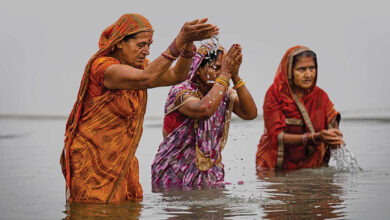Thirst for Power

Can the mighty Mekong River endure the PRC’s megadams?
FORUM Staff
It was the year a deadly contagion spread through a continent before crossing oceans and seas. A year when oil prices sank and pro-democracy protests broke out in Hong Kong as the world again bowed its head in remembrance of students and other demonstrators massacred in the Tiananmen Square uprising.
It was 2014 — a year of fears over an Ebola pandemic, a sputtering global economy and a ruthless People’s Republic of China (PRC).
There were less-heralded events that harsh year. Scientists announced the discovery of 139 new species in the Greater Mekong region of Southeast Asia, including a “dementor” wasp with a venomous sting that turns cockroaches into zombies before devouring them alive.
Elsewhere along the mighty Mekong River, construction of the Xayaburi Dam in Laos entered its second year, while hundreds of kilometers downriver, crews prepared to begin work on another hydropower dam, Don Sahong, near Laos’ border with Cambodia.
Meanwhile, in Ho Chi Minh City, Vietnam, leaders from Cambodia, Laos, Thailand and the host nation gathered for the quadrennial Mekong River Commission (MRC) summit. The commission member states were tasked with charting a course for the river’s sustainability. Looming over the summit: A cascade of megadams built by a power-thirsty PRC over the prior decade — and dozens of other planned hydropower projects, many of them to be funded and built by China — threatened the river, the region and its people.
Absent a drastic change of tack, portended an article about the summit in the online magazine The Diplomat, “2014 will surely be remembered as a tragic turning point for Southeast Asia’s most important river, and for the slow death of regional fisheries and agriculture.”
‘Mother of Waters’
Seven years after the MRC summit and a quarter century since the intergovernmental commission’s founding, how flows the future of the Mekong? Will this “Mother of Waters,” as it is known in Thai, remain an irreplaceable source of nourishment, a wellspring of life for a region? In the face of challenges man-made and natural, the answer is murky.

The Xayaburi and Don Sahong dams began operating within months of each other as the calendar turned from 2019 to 2020, and the world again found itself grappling with a pandemic, economic panic and political protest. According to the MRC, 11 other mainstream dams are operational along the Mekong River Basin, all of them on the upper Mekong in China, where the river is known as the Lancang. As of mid-2020, the MRC reported, the PRC planned 11 more mainstream dams on the upper Mekong, including one that was under construction. In addition to the Xayaburi and Don Sahong, nine more mainstream dams were planned along the Lower Mekong Basin, including four proposals that were being reviewed as part of the commission’s Procedures for Notification, Prior Consultation and Agreement. That process applies to “large-scale irrigation and hydropower development which may cause significant impacts on the environment, water flow and quality of the Mekong mainstream.”
The ripple effects of such projects on the world’s 12th-longest river already are substantial, according to research published in April 2020 that relied on daily river height gauges and satellite data collected over almost 30 years. Researchers from climate consultant Eyes on Earth and Global Environmental Satellite Applications developed a predictive model to determine how “the cascade of dams built on the Upper Mekong is altering the natural flow of the river.”
The U.S. Department of State-supported report, “Monitoring the Quantity of Water Flowing Through the Upper Mekong Basin Under Natural (Unimpeded) Conditions,” found that:
In 2019, the lower Mekong recorded some of its lowest-ever river levels despite an above-average natural flow from the upper Mekong.
The “severe lack of water in the Lower Mekong … was largely influenced by the restriction of water flowing from the Upper Mekong.”
The PRC’s 11 megadams along the upper Mekong can hold almost 48 billion cubic meters of water combined in their reservoirs. “The dams greatly expand the institutional capacity to regulate the river flow, with corresponding impacts downstream that need to be addressed through holistic solutions,” the researchers noted.
For some experts, the Eyes on Earth report cemented growing worries.
“It shines a dramatic light on how much water China’s upstream dams have blocked — even as downstream countries suffered through unprecedented drought,” Brian Eyler, senior fellow and director of the Southeast Asia program at the Stimson Center think tank, wrote in an April 2020 article for Foreign Policy magazine.
“Of the last 10 major droughts in the lower Mekong basin, eight have occurred since China’s first dam began construction,” Eyler, author of The Last Days of the Mighty Mekong, wrote in another article that same month on the think tank’s website.
Essentially, as the Stimson article’s headline stated, the PRC had “turned off the tap” on the Mekong, depriving riparian nations downstream of the most precious of resources — and leaving sovereign states at risk of being left high and dry.
Teeming with Life
The Mekong is the lifeblood of the region. Trickling into existence in the Tibetan plateau, “the roof of the world,” the river stretches more than 4,300 kilometers through the PRC, Burma, Thailand, Laos, Cambodia and Vietnam before emptying into the South China Sea. Along its journey, the Mekong drains an area larger than Thailand and Laos combined, while replenishing the fish and crops that have sustained the region’s people for millennia.
The largest inland fishery on the planet, the Mekong produces 25% of the world’s freshwater catch and is home to more than 1,000 species, from the endangered Irrawaddy dolphin to giant catfish weighing as much as a grizzly bear. The Greater Mekong region, dubbed Asia’s “rice bowl,” provides livelihoods and sustenance for about 80% of its 300 million inhabitants, according to the World Wildlife Fund (WWF). It brims with biodiversity; from 1997 to 2014, researchers discovered about three new species on average every week.
With unprecedented infrastructure development, including hydropower projects, much is at stake for the magical Mekong, “one of the most vulnerable places on Earth,” the WWF reported.
A 2010 report prepared for the MRC by the International Centre for Environmental Management found that the 80 or so dams then planned along the Mekong and its tributaries, including mainstream hydropower projects, could devastate the region’s fisheries by 2030. Fish production in the river basin could plummet by more than 40% from 2000 levels, threatening the nutrition and jobs of millions of people and increasing the risk of food insecurity.
The Mekong Agreement, which established the MRC in April 1995, calls on the four founding member states to cooperate “in a constructive and mutually beneficial manner in the sustainable development, utilization, conservation and management of the Mekong River Basin water and related resources.”
Cooperative efforts to protect the Mekong had begun four decades earlier when researchers were still exploring the “untamed” river from the backs of elephants “and there were signs of interest to capitalize on its economic potential,” according to the commission. The United Nations-endorsed Mekong Committee was formed with “responsibilities for financing, management and maintenance of water resources.” Eventually, the committee morphed into the commission.
In its first quarter century, the MRC established a slate of networks to gauge and nurture the Mekong’s health, from drought monitoring and flood forecasting to sediment collection and fisheries management guidance. The commission also points to its consultative process as bolstering collaboration and planning among member states and regional players to mitigate ecological and environmental damage from hydropower projects.
Additionally, in 2019, the MRC reached “a new level of cooperation” with its upper Mekong dialogue partners, the PRC and Burma, the commission’s chief executive officer, An Pich Hatda, wrote in the organization’s 2019 annual report.
Particularly in light of the Eyes on Earth study, the Stimson Center’s Eyler is among those who view the MRC as vital in addressing inequities in water resource distribution in the lower Mekong caused by the PRC’s upriver dams.
“Working through the Mekong River Commission … to achieve these ends is a best path forward,” he wrote.
Weaponizing Water
How far is the PRC’s authoritarian regime willing to go in addressing — let alone ensuring — water access? It’s a question with potentially life-or-death consequences for lower Mekong states. The Chinese megadams are, after all, an undeniable reality — concrete behemoths set to cast their shadow over the river for decades, if not centuries.
“While the presence of China’s dams cannot be altered, China can and should change the way it operates these dams,” Eyler wrote.
Observers, however, say the PRC uses its hydropower projects not just to store water and generate electricity for its 1.4 billion people but also as a bargaining chip to expand regional influence for its own ends. It has, in effect, weaponized water.
“While much attention has been given to the nation’s fearsome new military hardware, a formidable component in its arsenal has largely escaped notice: dams,” Eugene K. Chow wrote in an August 2017 article in The National Interest magazine.

Annually, water flowing from the PRC accounts for an estimated 16% of the Mekong’s total flow, although that can leap as high as 70% during droughts.
“By controlling the flow of the lifeblood of the region, China has gained enormous power, which has led to accusations of abuse,” Chow wrote.
The MRC’s response to the prospect of China waging water war has not always been viewed as full-throated. Rather, at times, the commission has seemed like a man tiptoeing around his own home so as not to draw the ire of a capricious giant living upstairs.
Case in point: its lukewarm response to the Eyes on Earth study.
In an April 2020 commentary note, the commission said the researchers had not adequately “taken into account the complexities of rainfall and runoff” and that their findings “do not align with the MRC’s observations on the ground.”
Citing “uncertainty” in the study’s use of satellite data, the commission said its own initial analysis “showed that the 2019 drought in the basin was due largely to insufficient rainfall during the wet season with a delayed arrival and earlier departure of monsoon rains and an El Nino event that created an abnormally higher temperature and higher evapotranspiration.”
While acknowledging that the PRC’s dams have altered water flows where the river enters the lower Mekong basin, the commission said that situation “brings both opportunities and challenges.”
It suggested more cooperation with the PRC was needed.
“To increase the transparency of dam operations and to demonstrate cooperation in good faith, China should consider providing more data,” the MRC concluded.
Like the commission, the PRC pointed the finger of blame at the skies. Though also “afflicted” by precipitation shortages, the PRC had “overcome various difficulties to increase the water discharge of the Lancang River and help Mekong countries alleviate the impact of the drought,” Foreign Minister Wang Yi claimed in February 2020.
“China will also consider sharing with the Mekong countries hydrological information for the whole year,” Wang said, according to a PRC Ministry of Foreign Affairs statement.
For many, this seemed to be another of the PRC’s empty promises.
Navigating the Future
The MRC’s calibrated response to the study may reflect a wider political reality highlighted by observers of the region: China’s money and might have muffled complaints.
Total Chinese investments and construction projects in Burma, Cambodia, Laos, Thailand and Vietnam surpassed U.S. $75 billion from 2010 to 2019, the Center for Strategic and International Studies, a U.S.-based think tank, reported in April 2020.
In the energy sector, the PRC was involved in the development of 18% of existing, planned or under construction projects in the Mekong region as of 2020, the Stimson Center reported.
“With control of the Tibetan plateau by dint of its geography, China is king of the hill when it comes to water in Asia and there is little downstream nations can do to change the whims of this monarch,” Chow wrote in The National Interest.
Other factors have hamstrung efforts to counter the PRC’s ability to choke the river’s flow downstream. In refusing to become a commission member, the PRC “effectively crippled” the organization, noted a June 2018 commentary published by the Royal United Services Institute, a United Kingdom-based defense and security think tank.
Further, border disagreements and ethnic frictions “continue to dog relations between the lower riparian states, often spilling over into the regional arena and complicating efforts to cooperate over the Mekong,” wrote commentator Brijesh Khemlani, a Bangkok-based analyst in Southeast Asian issues.
He called for fortifying multilateral entities, including the MRC and the U.S.-led Lower Mekong Initiative (LMI), as a bulwark against the PRC and to seed sustainable development.
“Chinese expansionism in the Mekong must be countered,” Khemlani warned, “for leaving matters as they are will be a recipe for disaster.”
The LMI, a partnership among Burma, Cambodia, Laos, Thailand, Vietnam and the U.S., marked its 10th anniversary in 2019. Its goal is to “deliver equitable, sustainable and inclusive economic growth” for the five Mekong partner nations structured around six pillars: environment and water, health, agriculture, connectivity, education, and energy security.
The initiative is supported by the Friends of the Lower Mekong, a consortium that includes Australia, the European Union, Japan, New Zealand, South Korea, the Asian Development Bank and the World Bank.
At an August 2019 event celebrating the LMI’s first decade, then-U.S. Secretary of State Mike Pompeo noted the partnership’s achievements but also highlighted “troubling trends.”
“We see a spree of upstream dam building which concentrates control over downstream flows,” he told ministers from the LMI nations. “The river has been at its lowest levels in a decade — a problem linked to China’s decision to shut off water upstream. China also has plans to blast and dredge riverbeds. … And we see a push to craft new Beijing-directed rules to govern the river, thereby weakening the Mekong River Commission.”
Pompeo announced a raft of new projects designed to protect the river and region, including:
The Japan-U.S. Mekong Power Partnership (JUMPP) to develop sustainable regional electricity grids and quality infrastructure, with initial U.S. funding of U.S. $29.5 million.
U.S. $14 million in funding for Mekong nations to fight transnational crime and trafficking, including stemming the methamphetamine trade in the Golden Triangle region encompassing parts of Burma, Laos and Thailand.
A South Korea-U.S. project to better use satellite imagery to evaluate flood and drought patterns along the Mekong.
An LMI water data-sharing platform and public impact program.
An Indo-Pacific conference to strengthen governance of transboundary rivers, including “a transparent, rules-based approach to the Mekong.”
“We will continue to help protect your sovereignty and security, help you prosper economically, and safeguard your rich cultures and environment,” Pompeo said.
Surging Demand
Prosperity begets development and an accompanying hunger for energy, fueling the drive to tap into renewable sources, such as hydropower. Humans have used water to generate power for thousands of years — today, hydropower accounts for about 70% of the renewable electricity produced worldwide, according to the National Geographic Society.
In unveiling the JUMPP project, the LMI noted that electricity demand in the Mekong nations is projected to rise about 6% annually. The U.S.-Japan effort will support “the unfettered flow of energy supplies in the Indo-Pacific region which is vital to the stability and development of the region.”
In March 2020, as the world fixated on the coronavirus scourge, there was some good news for the Mekong River: Cambodia announced a 10-year moratorium on mainstream dam development, shelving plans for its first two hydropower projects. Two months earlier, the nation’s grid had started importing power from the new Don Sahong Dam under a 30-year energy agreement with neighboring Laos.
Still, the new dams rise along the Mekong’s mainstream and tributaries, with more than 370 planned, The Washington Post newspaper reported in January 2020. Many of them are to be built by Chinese companies as part of the PRC’s One Belt, One Road scheme.
This, even as the MRC’s annual report in June 2020 warned of risks from development and reported that “severe droughts in the Lower Mekong Basin have caused substantial economic losses due to damages of agricultural crops, negative impacts on the environment, and adverse effects on people’s livelihoods.”
This, even as the PRC holds back water that could quench a region’s thirst.
In April 2022, leaders of the MRC’s four member states will gather in Laos for the commission’s next quadrennial summit. The overriding question then, as now, will surely be: How flows the future of the mighty Mekong?





